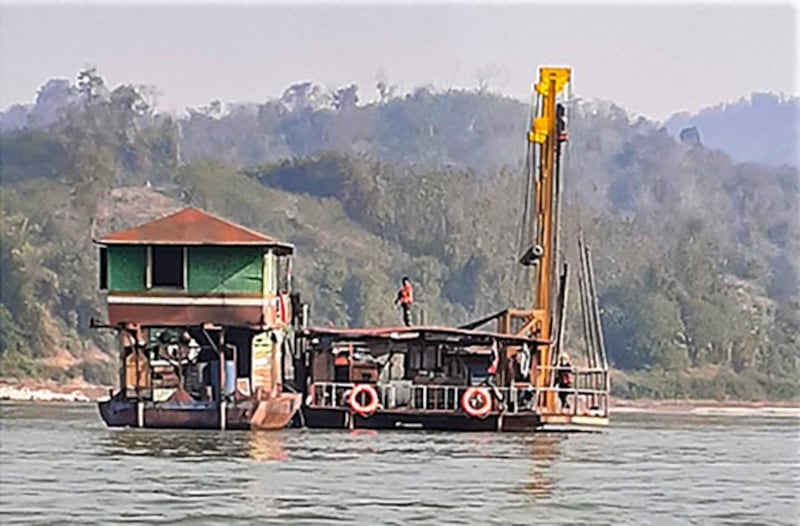Villagers in western Laos woke up in a panic last week to the sound of workers blasting rock to prepare for the building of a dam that would submerge their homes on the Mekong River.
They were distressed because the government has not clarified its relocation plans for them, or offered specific compensation.
“The authorities haven’t said anything about the relocation or the compensation, but I see [Chinese workers] are working in the water, blasting rock in the river,” one resident of the district, called Pak Lay in Xayaburi province, near the Thai border, said Thursday.
“I think that they’re building a bridge across the Mekong River,” he said, asking not to be identified for security reasons. “Because of the construction, we can’t fish anymore and boats can’t pass through anymore either.”
The problem is a typical one in Laos. As the country seeks to develop, build roads and dams and harness the mighty Mekong for hydroelectric power, authorities tend to neglect the needs and livelihoods of people who will be directly affected, as well as the environmental impact.
Local communities as well as environmental and humanitarian groups have said the Pak Lay Dam is expected to force the relocation of some 1,000 families from 20 villages and harm the surrounding ecosystem.
Still the Lao government appears dead set on proceeding with the US$2 billion Chinese-led project, which it hopes will bring the impoverished country closer to its goal of becoming the battery of Southeast Asia.
Green light
The residents’ comments came on the same day that an official with the Lao Ministry of Energy and Mines told Radio Free Asia that employees with China’s Sinohydro Corp. had begun building infrastructure for the Pak Lay Dam.
“The government has given the green light to the Chinese company to begin the construction of the basic infrastructure, including an access road and a bridge this year,” said the official, who declined to be named as he was not authorized to speak to the media.
“According to the plan, the company is going to start building the actual dam early next year” and complete it in 2029, he said.

Local residents decried the community’s lack of say in the decision-making process, and expressed concern about what kind of impact the dam will have on their lives.
“We villagers have no choice but to comply with the policy of the [ruling Communist] party and government,” said another villager from Pak Lay. “We want to oppose the project, but we can’t … fight against the party and government.”
“Of course we’re concerned about the relocation, the compensation and our [future] living conditions,” he said. ”We don’t know how much [the authorities] will pay for our losses and we don’t know whether our living conditions will be better or worse after the dam.”
Relocation before compensation
Laos has a grand plan to build dozens of hydroelectric dams along the Mekong and its tributaries and sell around 20,000 megawatts of electricity sto neighboring countries by 2030.
The Pak Lay Dam, expected to generate 770 megawatts, and the Pak Beng Dam in northern Oudomxay province, are two of the newest. The latter is expected to displace around 6,700 people living in 25 villages.
In November 2021, Thai power authorities agreed to purchase power generated by the two dams, both located 60-80 kilometers (35-50 miles) from the Thai border, and by the Nam Gneum 3 Dam on Nam River.
The Lao Ministry of Energy and Mines official told RFA last week that while the power purchase agreement for Pak Lay Dam has yet to be finalized by the Electricity Generating Authority of Thailand, the Lao government wants Sinohydro Corp. “to be prepared for the construction of the dam as soon as the [agreement] is signed.”
Villagers fear being shortchanged in the compensation they receive for their losses, as have other Laotians affected by hydropower dam projects.
An official with Xayaburi’s Natural Resources and Environment Department told RFA last week that his agency is still in the process of locating farmland for the residents who will be displaced. Once a site is procured, the government will begin building new homes for those affected, he said.
“When the relocation is complete the dam construction will begin, and only then can we talk about the compensation and the social and environmental impact – that’s the government’s policy,” said the official, who spoke on condition of anonymity.
The Xayaburi official said that the government is obligated to inform the community about the potential impact of the dam “in order to avoid conflict later,” although it was not immediately clear how much information had been provided to the Pak Lay villagers.
“If the dam is going to be built, we as local authorities will have to do our job according to the plan, which will include clearing land, building resettlement villages and improving living conditions for the affected villagers,” he said.
The official did not provide details of how the government plans to compensate the villagers or give a timeframe for the process.
Status of agreement uncertain
In the meantime, the Thai government has yet to confirm to members of the country’s NGO community whether it will proceed with an agreement to purchase electricity from the Pak Lay project, according to Hannarong Yaowalers, chairman of the Integration Water Management Foundation in Thailand.
“However, in general, I think that if the Lao government is moving this project forward, [the Lao government and investors] may have gotten the necessary funding for the construction,” he said. “They are unlikely to care about complaints [about the impact on the environment and fish population] previously lodged by the NGOs.”
Translated by Max Avary. Edited by Joshua Lipes and Malcolm Foster .
